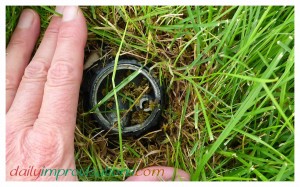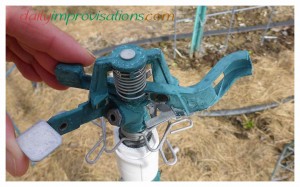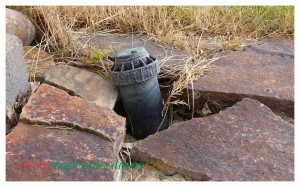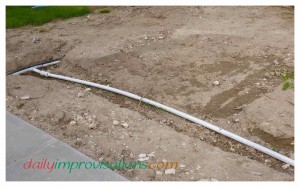There are three main concerns when turning on the sprinkler system in the spring:
- what date is the best
- remembering the steps and switches to activate the system
- is water going to all the right places
The date to turn on the sprinklers depends on what climate you live in and if your access to water is limited by water regulatory agencies. For instance, here in southwest Idaho, we generally want some access to outdoor yard water in early April. Even though there is likely to be another morning frost or two that limits what plants can survive, it will be warm enough that the sprinkler pipes are safe from freeze damage. However, anyone who is dependent on irrigation water coming from the canal and ditch network will not get their water until whoever is in charge of that decides to turn it on. Our neighbors used to have their sprinkler system fed by irrigation water. Their gardens and grass suffered many a dry spell in spring because that water was not turned on by then, the powers that be having declared that there was not enough in the reservoirs to let it flow until later in the spring.
Remembering exactly how to turn on the sprinkler system is usually at least a two step process. Since the water flow to the pipes was blocked so that they could be blown out in the fall, to avoid damage from the expansion of freezing water, some sort of valve needs to be turned to let the water back in. At our house, we have to make sure the drain valve gets closed before we turn the water back on. The turn on valve is “protected” by a long, wide pipe that is about a yard long, as long as the metal “key” used to turn the funny knob. It is dark down there and the knob is ancient and I can’t remember which way to turn it. It is always an “exciting” part of my spring.
Making sure the sprinkler timer is set properly, plugged in, and turned on is the next thing to do. I have read the manual for this “box,” but it might as well be a alien space ship control console. I understand my computer better. Still, somehow, I do get the sprinklers to start watering. I’m never sure exactly why, but if I keep pushing buttons the monster revives.
It is like a monster, with tentacles underground all over my acre. Semi-tamed and cooperative, yet it needs me. Every year parts are broken and misaligned. I have to watch everything as it goes through a complete cycle in order to evaluate. The first year I did this, I didn’t know how to skip to the next zone (set of sprinklers watering an area), so after playing dodge-the-sprinkler to see how everything was working for one zone, I would set a time to remind me when the next zone would be running. It takes several hours for our sprinklers to water our acre, so this was quite a day long project.
Nowadays, I can advance the cycles “at will,” but don’t ask me to explain how I do it. Judging by the fact that it doesn’t seem to “work the same” every time I do it, there is something I still don’t quite understand. However, I can get the sprinklers evaluated in a couple of hours now! I think I may enter an alternate state of mind, and I’m pretty sure I talk to the sprinkler box. We all have our special skills… hopefully you can discover yours, even if you don’t understand them, either.
I am getting to know my monster sprinkler system so well, that I was able to run it and observe it for all 8 zones, then come inside and write down every problem and concern on a piece of paper like I had been hypnotized. Maybe that is what actually happens when a person runs in swirls and switchbacks around the yard between moving fountains, only to stop and stare at water spraying in clock-like patterns while mechanisms click and snap all around.
There might be a better way. I belatedly remembered the chart we made for weeding last year and thought it could be handy to chart sprinkler status. If I didn’t have quite enough room for all my notes (some areas do have a lot of problems), I could stack sticky notes over a given sprinkler symbol or zone. There is the issue of being always a bit damp when working on sprinklers, so maybe having the chart secured to the picnic table on the patio, with a towel handy?
Here is a list of the types of problems to watch for:
- water spray needs to be adjusted both in distance and angle of circle covered
- ground level sprinklers do not sufficiently pop up or stay up
- pieces broken off of sprinkler heads, making them unadjustable or nonfunctioning (I wrote an article for D&B Supply last week explaining how I replaced a broken impact sprinkler head.)
- sprinkler spray blocked by plants, requiring pruning
- garden or landscape layout has changed enough that sprinkler heads need to be relocated
- sprinklers are leaking where they are attached to the underground pipes (Here is a link to one of my first successes with repairing underground sprinkler pipes.)
- sprinkler heads or filters are clogged with sand or debris from sediment in water
- pipes are broken or compressed by tree roots
- section of drip irrigation have blown out plugs or attachments directing water to specific spots. (I have not had as much trouble with this in places I’ve put in Netafim drip irrigation pipe.)
I have repaired a couple of the most important problems. Now every part of the yard is at least getting some water. Some issues will have to wait until fencing issues are resolved. Already, though, I have made more progress by myself with maintaining basic functionality than every before. That has left my husband “free” to deal with more major sprinkler re-designs having to do with putting in a sandbox for the grandkids and adding a large gate to an animal area. I’m sure he will be asking me if I want to “learn more” soon. Ah. Togetherness.





Leave a Reply